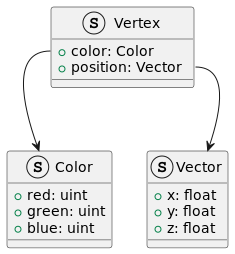Vertex (computer graphics)

A vertex (plural vertices) in computer graphics is a data structure that describes certain attributes, like the position of a point in 2D or 3D space, or multiple points on a surface.
Application to 3D models
3D models are most often represented as triangulated polyhedra forming a triangle mesh. Non-triangular surfaces can be converted to an array of triangles through tessellation
. Attributes from the vertices are typically interpolated across mesh surfaces.
Vertex attributes
The vertices of triangles are associated not only with spatial position but also with other values used to
vertex shader or vertex pipeline
.
Such attributes can include:
precomputed lighting
information.specular exponent
, metallicity, fresnel values.UV coordinates, these control the texture mapping
of the surface, possibly for multiple layers.tangent vectors
Blend weights
Bone weights
facial animation
.See also
For how vertices are processed on 3D graphics cards, see shader.
